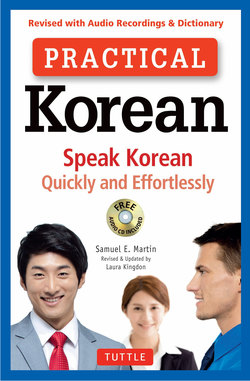Читать книгу Practical Korean - Samuel E. Martin - Страница 8
ОглавлениеLESSON 1
Vowels
The vowels and combinations of y or w with a vowel are pronounced somewhat as follows:
| i | ㅣ | as in marine (meet, cheat) | |
| wi | ㅟ | as in we(queen, between, sweet) | |
| e | ㅔ | This is pronounced identically to aein modern Korean. | |
| There isn’t an exact English equivalent. | |||
| ye | 예 | Halfway between “yay” and the “ye” in yes (or yeah) | |
| weh | ㅞ | More like the English word way, but about halfway to “weh.” | |
| ae | ㅐ | The closest English equivalent is like the English “eh”—sort of between “ay” and “e.” There isn’t an exact English equivalent. | |
| yae | ㅒ | Halfway between “yay” and the “ye” in yes | |
| wae | ㅙ | More like the English word way, but about halfway to “weh.” | |
| oe | ㅚ | usually pronounced just like the English word way,but halfway to “weh” | |
| a | ㅏ | as ah(father) | |
| ya | ㅑ | as yard, German ja | |
| wa | ㅘ | as Wahshington (but not Worshington or Wohshington!) | |
| eu | ㅡ | This is like the French sound eu—there is no English equivalent. | |
| u | ㅜ | as June, soon, too(WITH LIPS PUSHED OUT) | |
| yu | ㅠ | as you,cue, pew(WITH LIPS PUSHED OUT) | |
| eo | ㅓ | between song and sung; like song, law, bought (WITH LIPS PULLED BACK HARD); or like sung, lung, butt (WITH TONGUE PULLED BACK AND PUSHED DOWN, AS IF WITH A SPOON) | |
| yeo | ㅕ | between yawn and young | |
| wo | ㅝ | between wall and won | |
| o | ㅗ | as in no | |
| yo | ㅛ | as in yokel | |
| ui | ㅢ | The combination uihas three different pronunciations depending on the usage:(1) At the beginning of a word it is pronounced like u.(2) At the end of a word it is pronounced like i.(3) As a separate particle meaning of, it is pronounced like e. | |
| In this book, you will find the first pronunciation indicated as ui(i) and the second as eu i. But you will have to remember that the particle ui is pronounced like e. |
You will note that letters in Korean are not written independently as in English but rather are connected in syllables. Each syllable is read left-right and up-down, and some are only left-right while some are only up-down and some are both. Here are some examples:
Left-right: ㅇ (place marker) + ㅏ (a) = 아 (a)
ㄴ (n) + ㅓ (eo) = 너 neo
Up-down: ㄱ (g) + ㅗ (o) = 고 (go)
ㅇ (place marker) + ㅜ (u) + ㄹ (l) = 울 ul
Both: ㄴ (n) + ㅐ (ae) + ㅁ (m) = 냄 naem
ㅈ (j) + ㅣ (i) + ㄱ (k) = 직 jik
Here are some common words to practice the vowels on:
| i | tooth | 이 |
| jip | house | 집 |
| gwi | ear | 귀 |
| jwi | rat | 쥐 |
| dwi | behind | 뒤 |
| ne | yes | 네 |
| ye | yes | 예 |
| gyohoe | church | 교회 |
| hoeui | meeting | 회의 |
| Choe | Choe (name) | 최 |
| soe | iron | 쇠 |
| sae | bird | 새 |
| sonyeo | girl | 소녀 |
| agi | baby | 아기 |
| hae | sun, year | 해 |
| maeil | every day | 매일 |
| iyagi | story, talk | 이야기 |
| wae | why | 왜 |
| mal | horse | 말 |
| bam | night | 밤 |
| joreugi | badger; tighten | 조르기 |
| wanbyeok | perfect, perfection | 완벽 |
| gwanggo | advertisement | 광고 |
| eumsik | food | 음식 |
| eunhaeng | bank | 은행 |
| geurim | picture | 그림 |
| nun | eye; snow | 눈 |
| mu | turnip | 무 |
| yuri | glass | 유리 |
| dubu | bean-curd, tofu | 두부 |
| gyuyul | regulations | 규율 |
| meonjeo | first of all | 먼저 |
| eonje | when | 언제 |
| neomu mani | too much | 너무 많이 |
| gyeongjehak | economics | 경제학 |
| geokjjeong | worry | 걱정 |
| won | won (currency) | 원 |
| ssaum | fight | 싸움 |
| don | money | 돈 |
| sori | sound | 소리 |
| gong | ball | 공 |
| pyo | ticket | 표 |
| hakgyo | school | 학교 |
| uija | chair | 의자 |
| uisa | doctor | 의사 |
| uimi | meaning | 의미 |
| jipjung | attention | 집중 |
| uinon | discussion | 의논 |
